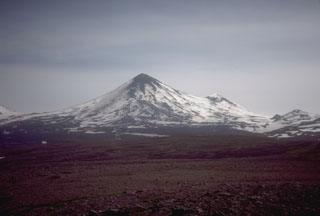Report on Pavlof (United States) — April 1986
Scientific Event Alert Network Bulletin, vol. 11, no. 4 (April 1986)
Managing Editor: Lindsay McClelland.
Pavlof (United States) Strong tremor accompanied large 18 April plume
Please cite this report as:
Global Volcanism Program, 1986. Report on Pavlof (United States) (McClelland, L., ed.). Scientific Event Alert Network Bulletin, 11:4. Smithsonian Institution. https://doi.org/10.5479/si.GVP.SEAN198604-312030
Pavlof
United States
55.417°N, 161.894°W; summit elev. 2493 m
All times are local (unless otherwise noted)
No other reports of activity had been received as of early May [but see 11:05], and no information was available about changes that might have occurred to the active crater.
John Taber provided the following information from seismic stations operated by LDGO. "The number of volcanic events increased from a slightly above normal 20 events on 6 April, to 370 events on 11 April and 750 events on 13 April. The rate of seismicity then stayed relatively constant until the main eruption on 18 April. Continuous tremor began at around 1440 and intensified around 1610, when it was visible at stations 100 km away. The strong tremor continued until 1800 then gradually subsided, ending around 2100. The number and duration of volcanic events dropped abruptly after the tremor ended and continued to decrease until background levels were reached by 26 April."
Geological Summary. The most active volcano of the Aleutian arc, Pavlof is a Holocene stratovolcano that was constructed along a line of vents extending NE from the Emmons Lake caldera. Pavlof and Pavlof Sister to the NE form a dramatic pair of symmetrical, glacier-covered stratovolcanoes that overlook Pavlof and Volcano bays. Little Pavlof is a smaller cone on the SW flank of Pavlof volcano, near the rim of Emmons Lake caldera. Unlike Pavlof Sister, eruptions have frequently been reported from Pavlof, typically Strombolian to Vulcanian explosive eruptions from the summit vents and occasional lava flows. The active vents lie near the summit on the north and east sides. The largest recorded eruption took place in 1911, at the end of a 5-year-long eruptive episode, when a fissure opened on the N flank, ejecting large blocks and issuing lava flows.
Information Contacts: J. Taber, LDGO.

